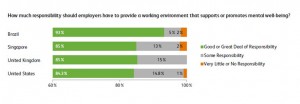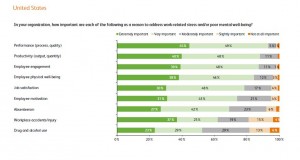 People with anxiety, depression, interpersonal challenges, and substance abuse go to work every day. Together, these factors erode the mental health and wellbeing of workers, and this negatively impacts companies’ productivity, workplace morale, and profitability.
People with anxiety, depression, interpersonal challenges, and substance abuse go to work every day. Together, these factors erode the mental health and wellbeing of workers, and this negatively impacts companies’ productivity, workplace morale, and profitability.
Employers are increasingly taking notice of their role in promoting mental health on-the-job, a trend captured in the report Promoting Mental Well-being: Addressing Worker Stress and Psychosocial Risks, an international survey of employers published in May 2015 by Buck Consultants, part of Xerox. The survey polled 439 employers in 31 countries, and the report focuses on the results in four of those nations: Brazil, Singapore, the United Kingdom, and the United States.
Most employers believe they have a responsibility to provide a work environment that supports mental well-being, shown in the first chart, with 84% of US employers supporting mental well-being at work. This percentage matches the global 84% of employers amongm the 31 countries.
But the US is strikingly and negatively ahead of the pack when employers rat the level of stress in their organization: “we’re number 1” in America for workplaces with high or very high levels of stress cited by 53% of employers. Combined with “moderate” levels of stress, that’s 97% of workplaces. Most companies in other countries see stress levels at a more moderate level. Clearly, though, stress is epidemic in workplaces around the world.
So it’s timely that the day this report was published Xerox announced its acquisition of the Healthy Communities Institute to bolster the company’s work in population health,
 US employers articulate a long list of reasons to deal with worker-related stress and mental well-being, ranked in the second graph. Among those ranked “extremely important” are performance, productivity, employee engagement, employee physical well-being, workplace accidents and injuries, employee motivation and job satisfaction.
US employers articulate a long list of reasons to deal with worker-related stress and mental well-being, ranked in the second graph. Among those ranked “extremely important” are performance, productivity, employee engagement, employee physical well-being, workplace accidents and injuries, employee motivation and job satisfaction.
The most popular tactics over one-half of US companies currently offer to deal with work-related stress include employee assistance programs (offered by 89% of employers), physical activity programs (83%), work/life balance programs (75%), online healthy lifestyle programs (74%), leadership training for individuals (73%), onsite fitness facilities (72%), financial well-being resources (68%), personal lifestyle coaching (68%), stress awareness (61%), health care advocacy (60%), time management skills (55%), guidance on effective communication (53%), and yoga, meditation and relaxation programs (50%).
Health Populi’s Hot Points: One in three US employees told Xerox and Buck that indicators of employees’ mental well-being, burnout, and workplace stress have gotten worse in the past 5 years, compared with 18% of companies globally. That’s nearly twice the rate of stress and mental ill-health exacerbating in US companies compared with the average of workers in 30 other countries.
Awareness is the precursor to action, and the bulk of US employers surveyed by Xerox and Buck found most are investing in a range of programs from exercise and on-site fitness facilities to yoga and stress reduction. But the outcomes thus far, given the five-year increase of stress at work, don’t appear to be translating into imrpoved worker mental well-being across the employee population.
Stress is an integral topic here on Health Populi because it’s part of life and whole health — which I covered recently in this post, Stress is US. Research from the Robert Wood Johnson Foundation found that, of course, stress is part of daily living, and should be considered an integral aspect in a culture of health. Employers are coming to that learning, which is a good thing — for employees, for productivity, and for health costs.
Mental health must be integrated into primary care and the overall health benefit so it’s not seen as “other than,” and instead can be addressed as the social determinant of health that it is.




 Interviewed live on BNN Bloomberg (Canada) on the market for GLP-1 drugs for weight loss and their impact on both the health care system and consumer goods and services -- notably, food, nutrition, retail health, gyms, and other sectors.
Interviewed live on BNN Bloomberg (Canada) on the market for GLP-1 drugs for weight loss and their impact on both the health care system and consumer goods and services -- notably, food, nutrition, retail health, gyms, and other sectors. Thank you, Feedspot, for
Thank you, Feedspot, for  As you may know, I have been splitting work- and living-time between the U.S. and the E.U., most recently living in and working from Brussels. In the month of September 2024, I'll be splitting time between London and other parts of the U.K., and Italy where I'll be working with clients on consumer health, self-care and home care focused on food-as-medicine, digital health, business and scenario planning for the future...
As you may know, I have been splitting work- and living-time between the U.S. and the E.U., most recently living in and working from Brussels. In the month of September 2024, I'll be splitting time between London and other parts of the U.K., and Italy where I'll be working with clients on consumer health, self-care and home care focused on food-as-medicine, digital health, business and scenario planning for the future...